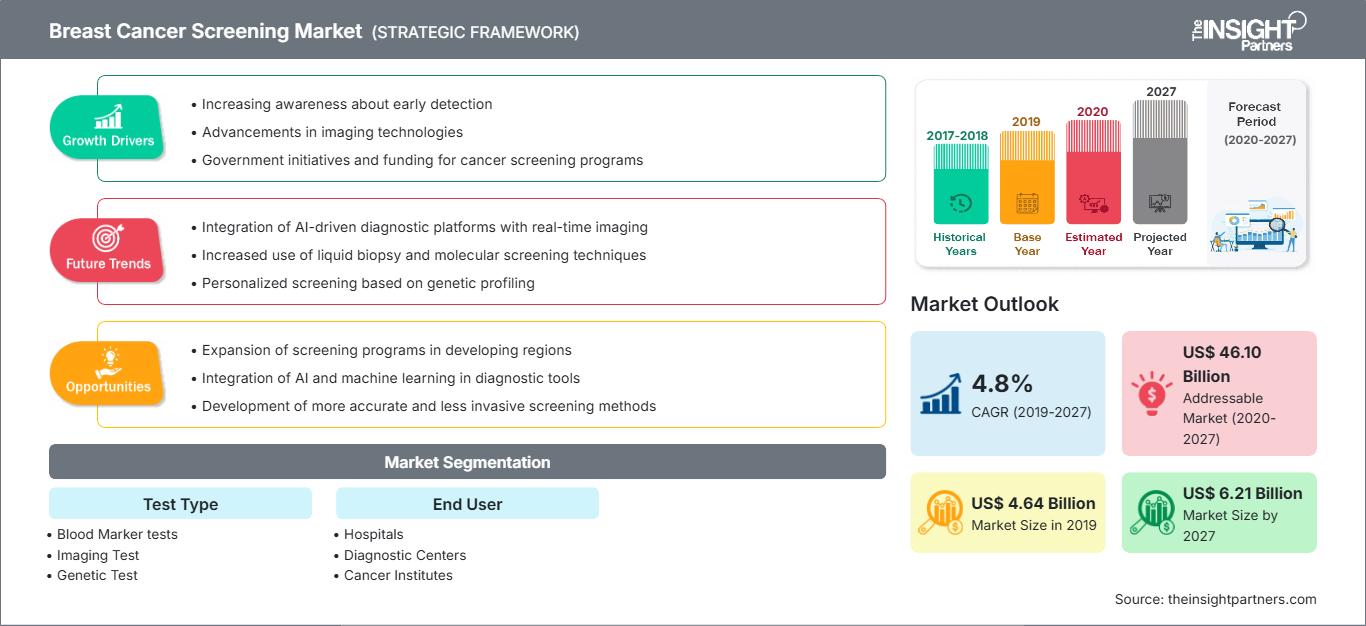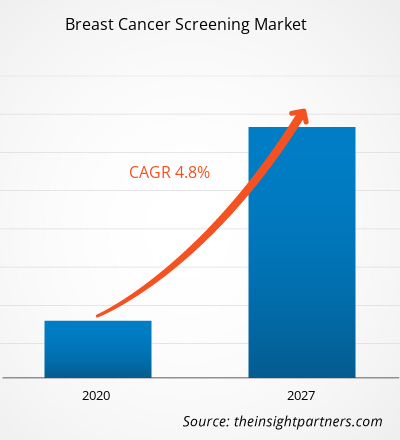[Forschungsbericht]Der Markt für Brustkrebs-Screening wird voraussichtlich von 4.638,63 Mio. USD im Jahr 2019 auf 6.209,25 Mio. USD im Jahr 2027 anwachsen; von 2020 bis 2027 wird ein durchschnittliches jährliches Wachstum von 4,8 % erwartet.
Brustkrebs ist die häufigste und am weitesten verbreitete Krebsart bei Frauen. Er entwickelt sich im Brustgewebe, normalerweise in den Milchgängen (Milchkanälen) und Läppchen (Milchdrüsen). Er kann auch im Fettgewebe oder Bindegewebe der Brust auftreten. Eine frühzeitige Diagnose von Brustkrebs ist wichtig, da sie einen kritischen Verlauf verhindern und eine erfolgreiche Behandlung gewährleisten kann. Zu den Screening-Methoden für die Diagnose von Brustkrebs gehören Mammographie, Magnetresonanztomographie (MRT), Ultraschall und andere. Das wichtigste Ziel des Screenings ist es, die Krankheit in ihrem frühesten und behandelbarsten Stadium zu erkennen. Die Screening-Verfahren erkennen die frühen Anzeichen von Krebs, noch bevor die ersten Symptome auftreten.
Passen Sie diesen Bericht Ihren Anforderungen an
Sie erhalten kostenlos Anpassungen an jedem Bericht, einschließlich Teilen dieses Berichts oder einer Analyse auf Länderebene, eines Excel-Datenpakets sowie tolle Angebote und Rabatte für Start-ups und Universitäten.
Markt für Brustkrebs-Screening: Strategische Einblicke

-
Holen Sie sich die wichtigsten Markttrends aus diesem Bericht.Dieses KOSTENLOSE Beispiel umfasst Datenanalysen, die von Markttrends bis hin zu Schätzungen und Prognosen reichen.
Markteinblicke
Global steigende Brustkrebsrate
Brustkrebs gehört zu den häufigsten Todesursachen weltweit und beeinträchtigt die Lebensqualität erheblich. Wird er nicht rechtzeitig diagnostiziert und behandelt, stellt er eine Belastung für die Gesellschaft dar. Nach Schätzungen der American Cancer Society ist Brustkrebs in den USA die häufigste Krebsart. Im Jahr 2018 erkrankten rund 234.087 Menschen daran, und 41.904 Menschen starben daran. Für 2020 werden in den USA rund 276.480 Neuerkrankungen erwartet. Dem Globocan-Bericht 2019 zufolge gab es in Deutschland im Jahr 2018 insgesamt 71.888 Brustkrebsfälle, und die Krankheit führte in diesem Jahr zu rund 19.376 Todesfällen. Darüber hinaus gab es laut dem Globocan-Bericht im Jahr 2018 in China rund 367.900 neue Fälle von Brustkrebs und 97.972 Todesfälle aufgrund desselben. In Indien legen NGOs, Regierungsbehörden und Wohltätigkeitsorganisationen Wert darauf, die Bevölkerung für Brustkrebs zu sensibilisieren, um eine frühzeitige Erkennung zu fördern, umfassende Behandlungsmodule bereitzustellen und die Unterstützung bei der Brustkrebsbehandlung auszuweiten. Solche Initiativen sind eine Folge der zunehmenden Verbreitung dieser Krebsart im Land. Laut Schätzung des Globocan-Berichts wurden in Indien im Jahr 2018 rund 162.468 neue Brustkrebsfälle und 87.090 Todesfälle aufgrund desselben gemeldet. Diese zunehmende Verbreitung von Brustkrebs in verschiedenen Regionen der Welt erhöht die globale Nachfrage nach entsprechenden Screening-Geräten.
Markteinblicke nach Testtypen
Der Markt für Brustkrebs-Screening ist nach Produkttypen unterteilt in Blutmarkertests, bildgebende Verfahren, genetische Tests und immunhistochemische Tests. Das Segment der bildgebenden Verfahren hatte 2019 den größten Marktanteil und dürfte im Prognosezeitraum auch die höchste durchschnittliche jährliche Wachstumsrate (CAGR) verzeichnen.
Endnutzerbasierte Erkenntnisse
Auf Basis der Endnutzer wurde der Markt für Brustkrebs-Screening in Krankenhäuser, Diagnosezentren, Krebsinstitute und Forschungslabore segmentiert. Das Segment Krankenhäuser hatte 2019 den größten Marktanteil, während das Segment der Diagnosezentren im Prognosezeitraum voraussichtlich die höchste durchschnittliche jährliche Wachstumsrate (CAGR) verzeichnen wird.
Produkteinführungen und -zulassungen sind eine häufig angewandte Strategie von Unternehmen im Markt für Brustkrebs-Screening, um ihre Präsenz weltweit auszubauen und die steigende Nachfrage durch die Erweiterung ihres Produktportfolios zu befriedigen. Sie verfolgen außerdem eine Expansionsstrategie, um ihren Kundenstamm weltweit zu vergrößern und so ihren Markennamen weltweit zu behaupten. So erhielt Siemens Healthineers im Juni 2017 die Zulassung der Food and Drug Administration (FDA) für das Produkt syngo.via VB20, das voraussichtlich für die molekulare Bildgebung (MI) von Siemens Healthineers verwendet wird – eine neue Version der etablierten intelligenten Visualisierungssoftware des Unternehmens für multimodale Bildgebung.
Markt für Brustkrebs-Screening
Die Analysten von The Insight Partners haben die regionalen Trends und Faktoren, die den Markt für Brustkrebs-Screening im Prognosezeitraum beeinflussen, ausführlich erläutert. In diesem Abschnitt werden auch die Marktsegmente und die geografische Lage in Nordamerika, Europa, dem asiatisch-pazifischen Raum, dem Nahen Osten und Afrika sowie Süd- und Mittelamerika erörtert.Umfang des Marktberichts zum Brustkrebs-Screening
| Berichtsattribut | Einzelheiten |
|---|---|
| Marktgröße in 2019 | US$ 4.64 Billion |
| Marktgröße nach 2027 | US$ 6.21 Billion |
| Globale CAGR (2019 - 2027) | 4.8% |
| Historische Daten | 2017-2018 |
| Prognosezeitraum | 2020-2027 |
| Abgedeckte Segmente |
By Testtyp
|
| Abgedeckte Regionen und Länder |
Nordamerika
|
| Marktführer und wichtige Unternehmensprofile |
|
Dichte der Marktteilnehmer für Brustkrebs-Screening: Verständnis ihrer Auswirkungen auf die Geschäftsdynamik
Der Markt für Brustkrebs-Screening wächst rasant. Die steigende Nachfrage der Endverbraucher ist auf Faktoren wie veränderte Verbraucherpräferenzen, technologische Fortschritte und ein stärkeres Bewusstsein für die Produktvorteile zurückzuführen. Mit der steigenden Nachfrage erweitern Unternehmen ihr Angebot, entwickeln Innovationen, um den Bedürfnissen der Verbraucher gerecht zu werden, und nutzen neue Trends, was das Marktwachstum weiter ankurbelt.

- Holen Sie sich die Markt für Brustkrebs-Screening Übersicht der wichtigsten Akteure
Markt für Brustkrebs-Screening – nach Produkttyp
- Blutmarkertest
- Bildgebender Test
- Gentest
- Immunhistochemischer Test
Markt für Brustkrebs-Screening – nach Anwendung
- Diagnosezentren
- Krankenhäuser
- Forschungslabore
- Krebsinstitute
Brustkrebs-Screening – Nach Geografie
- Nordamerika
- USA
- Kanada
- Mexiko
- Europa
- Frankreich
- Deutschland
- Italien
- Großbritannien
- Spanien
- Übriges Europa
- Asien Pazifik
- China
- Indien
- Südkorea
- Japan
- Australien
- Übriger Asien-Pazifik
- Naher Osten und Afrika
- Südafrika
- Saudi-Arabien
- VAE
- Übriger Naher Osten und Afrika
- Süd Amerika
- Brasilien
- Argentinien
- Rest des Südens Amerika
Unternehmensprofile
- General Electric Company
- Siemens Healthineers AG
- Exact Sciences Corporation
- Koninklijke Philips NV
- Hologic, Inc.
- BD
- Myriad Genetics, Inc.
- Oncozyten Corporation
- Danaher
- POC Medical Systems
- Historische Analyse (2 Jahre), Basisjahr, Prognose (7 Jahre) mit CAGR
- PEST- und SWOT-Analyse
- Marktgröße Wert/Volumen – Global, Regional, Land
- Branchen- und Wettbewerbslandschaft
- Excel-Datensatz
Aktuelle Berichte
Verwandte Berichte
Erfahrungsberichte
Grund zum Kauf
- Fundierte Entscheidungsfindung
- Marktdynamik verstehen
- Wettbewerbsanalyse
- Kundeneinblicke
- Marktprognosen
- Risikominimierung
- Strategische Planung
- Investitionsbegründung
- Identifizierung neuer Märkte
- Verbesserung von Marketingstrategien
- Steigerung der Betriebseffizienz
- Anpassung an regulatorische Trends






















 Kostenlose Probe anfordern für - Markt für Brustkrebs-Screening
Kostenlose Probe anfordern für - Markt für Brustkrebs-Screening